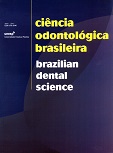Effect of previous desensitizer and rewetting agent application on shear bond strength of bonding
DOI:
https://doi.org/10.14295/bds.2006.v9i4.449Resumen
This study evaluated the effect of desensitizer and rewetting agent on dentin shear bond strength. One hundred thirty five bovine incisive teeth had their buccal surfaces ground down to produce a fl at superficial dentin surfaces and received the following treatments: G1- One Step Plus (OSP) and resin cylinder adhesive fi xation (RI); G2- Gluma One Bond (GOB) and RI; G3- Single Bond (SB) and RI; G4- Aqua-Prep (AP) + OSP and RI; G5- Gluma Desensitizer (GD) + GOB and RI; G6- GD + SB and RI; G7- GD + OSP and RI; G8- AP + GOB and RI; G9- AP + SB and RI. The specimens were stored at 37°C and 100% humidity for 24 hours and a shear bond test was performed with a mechanical testing machine, at a crosshead speed of 0.5 mm⁄min. The data were submitted to one-way ANOVA followed by the Tukey test (p<0.05). The results (MPa) were: G1: 10.75(2.64)a; G2: 10.28(2.58)a; G3: 11.63(4.59)a; G4: 10.93(4.88)a; G5: 10.15(3.95)a; G6: 11.82(4.14)a; G7: 9.85(2.15)a; G8: 5.48(1.94)b; G9: 10.62(2.83)a. The resistance of the GOB adhesive system was negatively affected by AP application. The use of desensitizer and rewetting agent does not compromise the bond strength when they are compatible with the adhesive system used.
Descargas
Descargas
Publicado
Cómo citar
Número
Sección
Licencia
Brazilian Dental Science uses the Creative Commons (CC-BY 4.0) license, thus preserving the integrity of articles in an open access environment. The journal allows the author to retain publishing rights without restrictions.
=================
COPYRIGHT TRANSFER AND RESPONSIBILITY STATEMENT
(PDF)
For all articles published in the BDS journal, copyright is retained by the authors. Articles are licensed under an open-access Creative Commons CC BY 4.0 license, meaning that anyone may download and read the paper for free. In addition, the article may be reused and quoted, provided that the original published version is cited. These conditions allow for maximum use and exposure of the work while ensuring that the authors receive proper credit. All metadata associated with published articles is released under the Creative Commons CC0 Universal Public Domain Dedication.
Before the submission, authors must obtain permission to reproduce any published material (figures, schemes, tables, or any extract of a text) that does not fall into the public domain or for which they do not hold the copyright. Permission should be requested by the authors from the copyright holder (usually the Publisher, please refer to the imprint of the individual publications to identify the copyright holder).
The authors hereby attest that the study is original and does not present manipulated data, fraud, or plagiarism. All names listed made a significant scientific contribution to the study, are aware of the presented data, and agree with the final version of the manuscript. They assume complete responsibility for the ethical aspects of the study.
This text must be printed and signed by all authors. The scanned version should be submitted as supplemental file during the submission process.




























